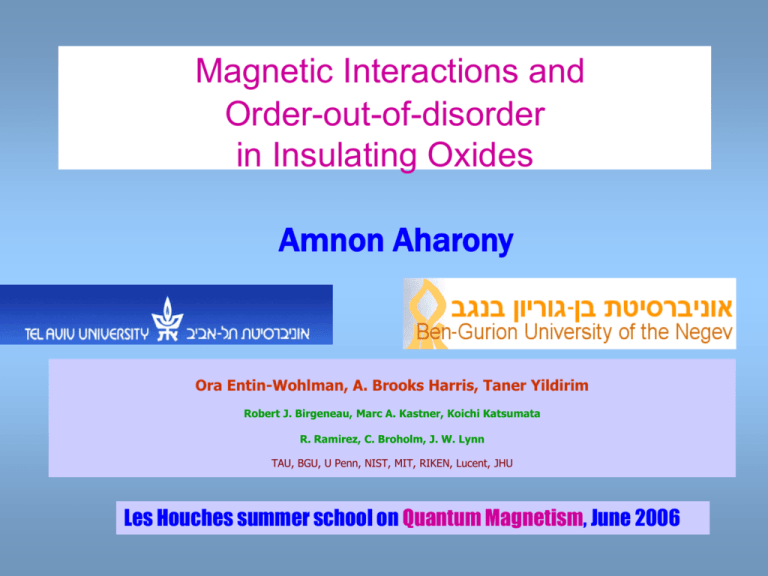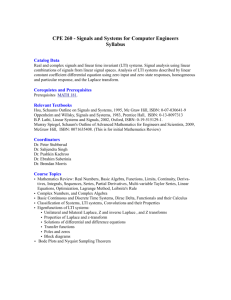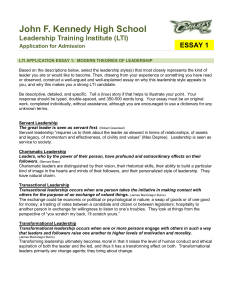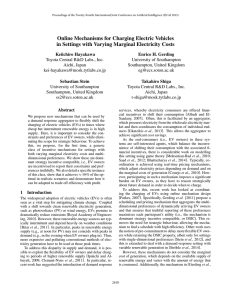Lecture 3
advertisement

Magnetic Interactions and Order-out-of-disorder in Insulating Oxides Amnon Aharony Ora Entin-Wohlman, A. Brooks Harris, Taner Yildirim Robert J. Birgeneau, Marc A. Kastner, Koichi Katsumata R. Ramirez, C. Broholm, J. W. Lynn TAU, BGU, U Penn, NIST, MIT, RIKEN, Lucent, JHU Les Houches summer school on Quantum Magnetism, June 2006 Lecture 3: Vanadates: Competing nn and nnn interactions yield Incommensurate order Competing anisotropies yield complex field dependent phase diagrams Ni and Co have very different magnetic structures Theoretical tools introduced in pervious lectures suffice to 2explain most features General outline: Cuprates Lecture 3 3 Vanadates Buckled Kagome Ni3V2O8 S=1 4 Co3V2O8 S=3/2 Ni3V2O8 5 Co3V2O8 Buckled Kagome Crystal Structure of Ni3V2O8 Only magnetic (S=1) Ni ions are shown b ? a Cross-tie is c 6 Cross-tie Spine FRUSTRATED Ni3V2O8 7 H || a Magnetic Field (T) 5 0 H || b 5 0 5 H || c 0 0 2 4 6 8 10 Temperature (K) 8 9 Specific heat Weak ferromagnetism in C phase Neutron scattering intensities in C, LTI and HTI Incommensurate wave vector 10 MAGNETIC PHASE DIAGRAM OF Ni3V2O8 Paramagnetic HTI = High Temperature Incommensurate Phase LTI = Low Temperature Incommensurate Phase CAF = Antiferromagnetic + weakly ferromagnetic CAF’ = Incommensurate? 11 MAGNETIC PHASE DIAGRAM OF Ni3V2O8 12 Theory Step I: Main interactions along spines: Superexchange, Ni—O—Ni and Ni—O—O--Ni H J1 (S1 S2 ) J 2 (S1 S3 ) H A O Ni O Ni O Ni Ni Explain HTI, LTI, CAF 13 Incommensurability? -- simplest model: H J1 (S1 S2 ) J 2 (S1 S3 ) H A HTI S n ( S cos( qna ),0,0) LTI S n ( S1 cos(cos( qna ), S 2 sin( qna ),0) (q locked in) cos(qa) J1 /( 4 J 2 ) 14 At low T, anisotropy wins again CAF Step II: Anisotropy comes from spin orbit interactions Spin-orbit interaction generates Antiferromagnetic bond-dependent spin anisotropy Also Dzyaloshinskii-Moria antisymmetric exchange O Ni 15 Ni Oxygen tilted along z Bilinear coupling between staggered Moment along a and ferromagnetic Moment along c D along y, AFM along x FM along z Step III: spin on cross-tie NI? Pseudodipolar interactions y x y x II I1 16 II I2 I1 I2 More recent results: Multiferroic behavior Ferroelectric moment along b, only in LTI phase! Can switch ferroelectric moment with magnetic field! 17 PHASE DIAGRAM b a H || a 5 0 P( mC/m2) Magnetic Field (T) SPONTANEOUS POLARIZATION 5 T=4K P || b 0 H || c 5 H || c T=5K 0 0 2 4 6 8 10 Temperature (K) 0 0.5 1 1.5 2 2.5 Magnetic Field (T) 18 3 3.5 LANDAU THEORY WITH TWO ORDER PARAMETERS 2 4 2 F a (T TM ) M b M c (T TP ) P d P 4 THIS DOES NOT WORK!! WE DO NOT BELIEVE IN ACCIDENTAL DEGENERACY (TP = TM). ALSO BOTH M AND P DEPEND STRONGLY ON H, SO 2 2 F a (T TM ) M b P P M x THEN, WHEN WE MINIMIZE WITH RESPECT TO P, P APPEARS ONLY WHEN M IS NONZERO: x 19 P const M MAGNETOELECTRIC COUPLING H xy a x, y , x ( q) y ( q) P where x,y are LTI or HTI and = x,y,z (q) = (-q)* is an order parameter In the HTI phase we have a single order parameter which has a node at some lattice site. About this site there will be inversion symmetry. So 20 I (q) = (-q) = (q)* I = inversion operator H a | ( q) |2 P ( IH = H) =0 MANETOELECTRIC INTERACTION Thus the trilinear magnetoelectric interaction is of the form H= HTI LTI P + d P2 So, after we minimize with respect to P: P = const HTI 21 LTI = const LTI This qualitatively explains the dependence of P on T and H Can arise from DM and PD interactions Confirm mean field trilinear term from microscopic Hamiltonian 22 B2u-phonons Mode Number: 64 Mode Energy: 69.24 meV (experimental value is about 80 meV!) Dipole Moment: 0.4612 (One of the largest Connected to V dipole moment!) Mode Description: Two oxygen atoms connected to cross-tie Ni moves along b-axis, significantly effecting the Ni-O-Ni bond angle for the spine spins (see the animations; side and top views). Spine-spins (a-axis) Cross-tie b-axis 23 24 25 Phys. Rev. B, in press 26 (Spins along spine parallel to each other) FM, d=0 AFM, d=1/2 27 Theory x(J3) 28 Quartic terms Higher harmonics Lock-in Lock-in 29 Dielecric constant Ferroelectricity??? 30 Conclusions: Vanadates are almost frustrated; interesting phase diagrams Can explain incommensurate phases by competing interactions Multiferroics! 31 THE END 32







